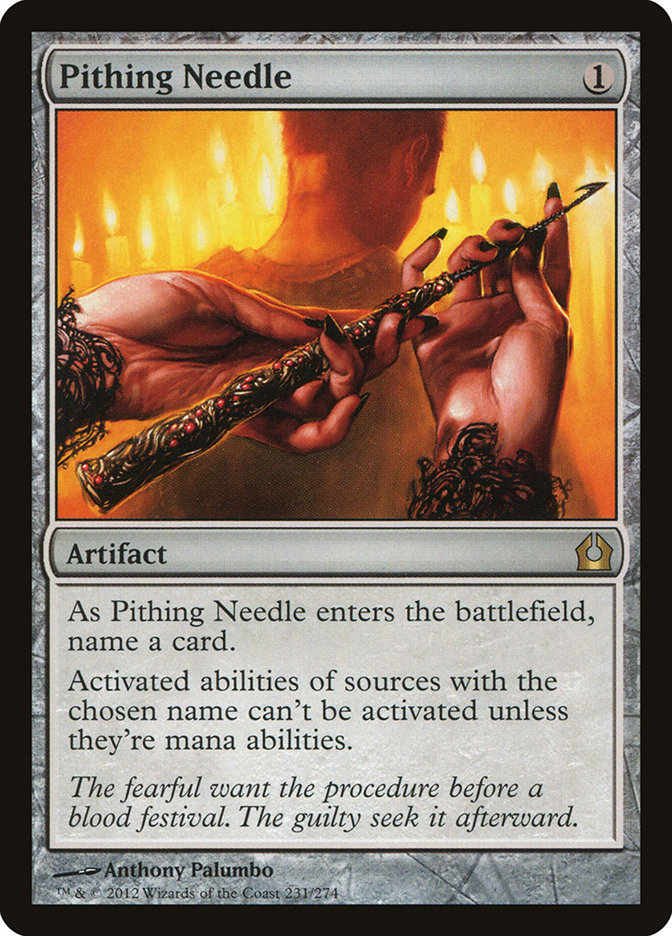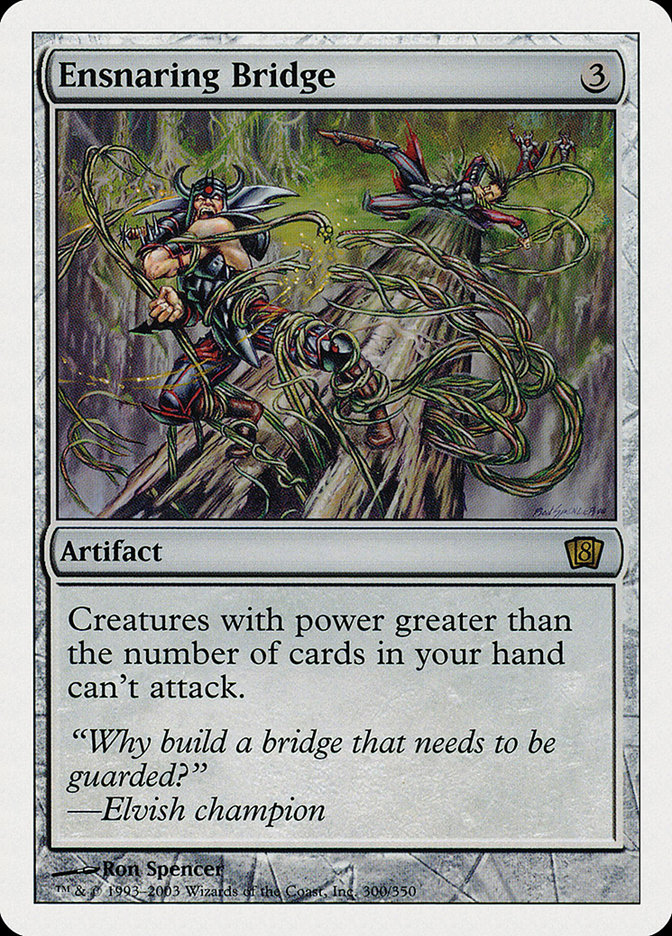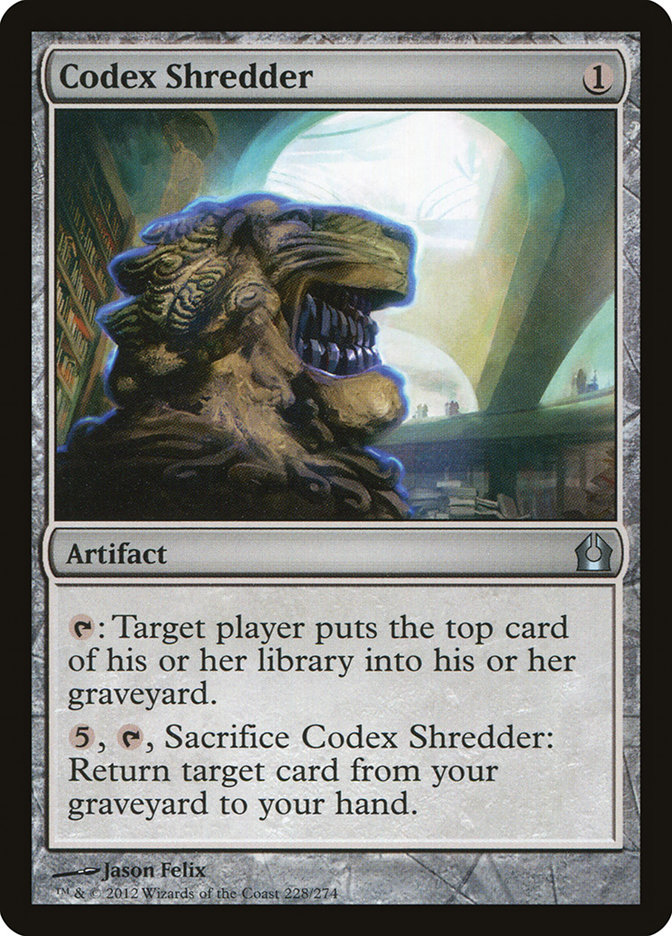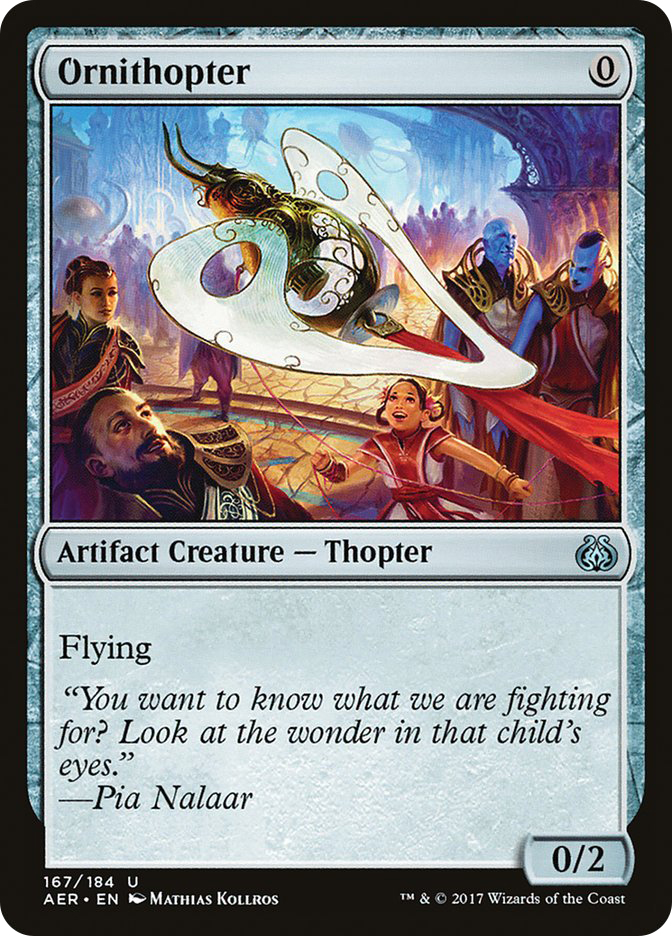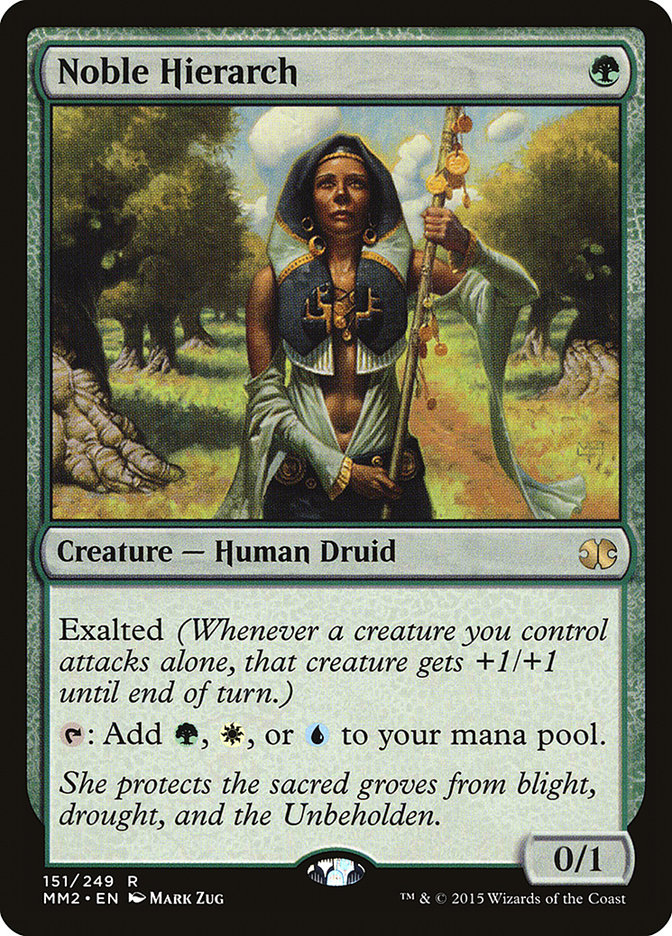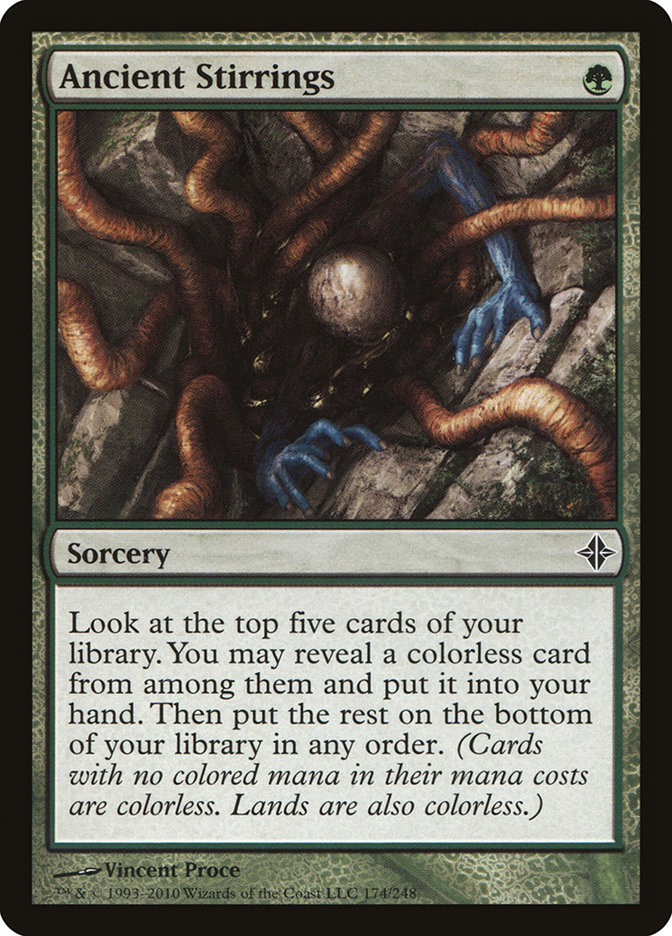Lantern Control won the Modern Pro Tour.
The deck that once featured Ghoulcaller’s Bell and still has several cards
you’d begrudgingly put into your draft pile as a fifteenth pick defeated a
field full of Snapcaster Mages, Lightning Bolts, and Noble Hierarchs. This
should’ve been a true underdog story that reaffirmed our faith in Magic and
cemented the great place where the Modern metagame currently finds itself.
Instead, there was widespread anger directed toward the deck for being
unfun and calls for the ban of Ancient Stirrings or Mox Opal in order to
curb the deck’s power. These calls came despite the fact that a scant nine
players played the deck in the tournament. That’s two percent of the field.
The deck was far from dominant, but it was well-positioned against the most
popular decks in the room, and Luis Salvatto had plenty of experience with
his deck of choice and enough poise to overcome a game loss in his win and
in match that would’ve easily derailed most players.
A great player, playing a well-positioned deck that they have plenty of
practice with is exactly who we should want to be winning at the highest
levels of Magic. This Pro Tour was a triumph on every level, and the
victory for Lantern Control was a big part of that. This is a deck that
should be celebrated rather than vilified, because it represents so much of
what makes Magic the best game ever made.
It’s Very Intricate
Most of the decks that have come to be loathed by a wide section of the
community have done so on the basis that they are overly simplistic,
requiring little skill to pilot but are too powerful to be effectively
stopped if they draw well enough. Tron is just slamming a Karn Liberated on
turn 3, Dredge is just turbomilling yourself and putting creatures onto the
battlefield for free, and Burn is just pointing all your spells at your
opponent’s face.
These complaints are all unfounded to varying degrees since every deck has
its own characteristics that a good pilot should learn, and for most linear
decks you need to learn how to tune your list for different metagames,
sideboard without diluting your gameplan too much, and what the common hate
cards for your strategy are and how to best combat them. However, much of
the work of these bogeymen is done by ignoring what the opponent is doing,
which many find upsetting.
However, Lantern is incredibly intricate precisely because it has to be
intimately familiar with what each of its opponents is doing. Lantern
pilots need to know what the cards their opponents have that can break out
of the lock so they know what to name with Pithing Needle, how important it
is to land an early Ensnaring Bridge to protect their life total from
reach, and just how many Codex Shredders they need to complete the lock.
These questions get easier when you gain perfect information with Lantern
of Insight and the discard spells, but Lantern pilots have to be aware of
what the entirety of their opponent’s deck is capable of since their plan
involves going through every card, so metagame knowledge is incredibly
important.
They also need to be aware of exactly which pieces they need to find in any
given matchup and aggressively use their Codex Shredders as card selection
tools to find them. Games with Lantern Control are often decided by a turn
or two as the opponent frantically tries to end the game before the last
wall of their prison cell is erected, so every additional card seen can
make the difference in a game.
Closing the game once a lock is established is easy with a bit of practice,
but getting to that point is the real meat of playing the deck, and it is
anything but simple. Those who lambast the “dumbing down of Magic” as
creatures have become more powerful, spells more heavily conditioned, and
curving out more important should praise the emergence of a deck that
rewards an intimate knowledge of your deck as well as your opponent’s.
The End Game is a Very Small Part of the Deck
Most of the complaints surrounding Lantern Control revolve around the unfun
play pattern of having all your relevant cards milled away while your
creatures are unable to attack. Well I agree. That’s not very fun. But it
also only happens once the game is effectively over, and doesn’t last
particularly long once the Lantern players gets a few Codex Shredders on
the battlefield.
Also, every deck that plays for the long game aims to establish a game
state where their opponent has no more relevant actions to take while you
kill them with whatever is laying around. Do you complain when your control
opponents attack you ten times with a Snapcaster Mage while countering
every spell you play? That’s essentially what’s going on here, but because
you start with 60 cards it takes a little longer.
I remember when Nephalia Drownyard was in Standard, and it was the most
common way that U/B Control decks ended the game, especially in control
mirrors or grindy midrange matchups. No one called for the card to be
banned for being unfun. Sure, traditional milling still leaves the opponent
with the illusion that the top of their deck may get them out of their
perilous position, but trust me, once your opponent started going for your
library the game was over. Lantern Control takes heat for doing the same
thing only because it shatters that illusion.
Still, it’s not particularly fun to have to sit there and wait for your
opponent to slowly drain your library while you do nothing, and were decks
like Lantern Control a huge portion of the metagame that would be
problematic. But as I mentioned earlier, Lantern was only two percent of
the Day One metagame at the Pro Tour. You’re not in danger of having to
play against the deck two, three, or four times per tournament. It’s not
overpowered and there are plenty of decks that have favorable matchups
against it and solid sideboard options for every deck.
I expect the deck to get more popular as it’s been underrated for a while
now, but Modern has more than enough tools to contain it. Bring your
Ancient Grudges, put more Tireless Trackers in your deck, and leave your
fetchlands uncracked when possible.
It’s Completely Unique
I mentioned Ghoulcaller’s Bell but did anyone think five years ago that
Lantern of Insight or Codex Shredder would ever see play in a competitive
Modern deck?
I believe Modern has been in a great place for a year now, but there are
still plenty of players that complain the format’s diversity is a facade,
and while there may be a huge number of nominally different archetypes to
choose from, on a strategic level the decks are very similar, and mostly
linear and aggressive.
The reality is that Modern has control decks, aggro decks, combo decks, and
midrange decks all playing prominent roles in the metagame right now, but
even amidst that diversity Lantern is different. Lantern, while labeled a
control deck, is really a prison deck. It aims to assemble a position where
the opponent has no relevant actions to take, and does so with
predominantly proactive plays rather than running them out of resources
with removal, counterspells, and card draw.
While the focus of its detractors is always on the unfun end game of the
deck, the relevant portion of the game against Lantern is quite interesting
precisely because it’s different than 90% of the games of Magic you’ll
play. You have more information with which to make decisions, and need to
use that information to leverage your fetchlands and card selection spells
to attain the highest possible number of uninterrupted draws you can in
order to have the best chance of breaking their lock or applying enough
pressure to end the game before the lock is established.
It’s still a min-max, risk-reward calculation, but it’s one that is done
with wildly different parameters, which is great. You have to be wary of
the size of your creatures and the cards in your opponent’s hand for
Ensnaring Bridge, the diversity of answers you have so Pithing Needle isn’t
too damaging, and potential ways you can force Grafdigger’s Cage and
Witchbane Orb to be necessary elements of the lock. Much like control
decks, you want to force them to fight on multiple fronts and make the lock
as complicated as possible, and there are several ways to do that.
I mentioned Tireless Tracker above, and it’s incredibly good here. Most
Lantern players actively look to mana flood their opponents, and Tracker
turns those excess lands into cantrips, ultimately overloading their Codex
Shredders.
Zero-power creatures like Ornithopter and Noble Hierarch are also good,
since they can attack through an Ensnaring Bridge to deal the last few
points of damage.
I’m sure that Lantern pilots have been gaining a significant advantage
because their opponents don’t understand the matchup very well, while they
do, and that gap should close quickly if the deck picks up in popularity.
Lantern’s emergence is giving us all an opportunity to solve another
puzzle, and one that isn’t like any other before. For that we should be
excited and grateful, not full of resentment.
It’s a Community-Built Deck
Zac Elsik’s victory at Grand Prix Oklahoma City in 2015 was the deck’s
first taste of the big stage in a major tournament, and for that Zac
received the credit for creating the deck in the first place. In reality,
the deck originated on an online forum, conceived and tuned by unheralded
members of the Magic community, and Zac merely built upon and advanced
their creation because of his undying love for rogue decks with lots of
artifacts.
In my early days in competitive Magic, I spent a lot of time on online
forums debating deck ideas, sideboard plans, and metagame predictions. It
was a time when I was completely enthralled with Magic and spent most of my
waking hours thinking about it and seeking out others who were so inclined.
I learned a lot from those online discussions, but never did I see
something so fruitful come from them as a previously undiscovered deck
capable of winning at the highest profile tournaments in Magic.
Lantern Control is the result of countless hours of effort and is truly an
ingenious deck. Sure, it uses powerful Modern staples like Ancient
Stirrings, Mox Opal, and Thoughtseize, but you need some superstars to
compete. In spite of the power level of those cards, this deck is so much
more than the sum of its parts and it’s no surprise that the deck took
years to come together and a couple key additions to push it over the top.
Later innovations in the deck came from top players who had picked it up
once it was firmly on everyone’s radar, but there’s no way a professional
Magic player is going to put in the time tuning a deck built around Lantern
of Insight and Codex Shredder. The likelihood of success would be
astronomically low. Lantern Control had to be a community built deck
because the wider Magic community is the only group optimistic enough to
think it could work.
And predictably, their creation was initially mocked. Even after Elsik’s GP
win the deck was not taken seriously. [The first instance I saw of the deck
putting up a result was a 2nd place at an Invitational Qualifier in early
2015. I got the link to the decklist circulating and it was mocked by many
prominent players. A similar reaction took place when Collins Mullen gave
Modern Humans its first big result recently. Some things never
change.–Ed.] But over time, and with the addition of some new cards,
Lantern has become a real contender. For anyone first starting to play
Magic competitively, succeeding at the highest levels with a brand new deck
of your own creation is the dream. And those people who were working on
this deck years ago got to live a piece of that dream.
When you play Magic professionally, it loses a bit of the aura it had when
you first started playing. You spend hours grinding with the best decks
trying to figure out the best sideboard plans and tune the last couple
slots in a decklist, and you tend to stay within fairly strict parameters
because you only have a week or two to prepare for any given tournament.
There isn’t much time for wild exploration and unrestrained brewing the way
we all started playing.
The emergence of Lantern Control is a reminder that those things still have
a place in professional Magic. There’s still room for players to think
outside the box (or in this case outside the galaxy) and come up with
something truly new while still remaining competitive. Before Lantern
Control I would’ve been immediately skeptical of any outlandish deck like
that, but now I can’t help but think that Modern is a big enough format to
be hiding many other off the wall decks. What else have we missed while
being blinded by Tarmogoyf, Lightning Bolt, and Serum Visions?
Magic is so much more than Pro Tours and Grand Prix, than metagame
breakdowns and win percentages. It’s a game predicated on the fact that the
number of combinations of cards and decks is functionally infinite. We will
never fully know everything there is to know about Magic, or even one
aspect of Magic. But the thirst to know just a little bit more is enough to
keep us all coming back for more.
The infinite modularity and eternal replayability of Magic is perfectly
displayed in Lantern Control’s victory last weekend. And while there was a
lot of shade thrown its way, I was happy to see many players come out in
defense of the deck and its deserved place in the Modern metagame. Modern
is a better format and Magic is a better game when decks like Lantern are
competitive.


